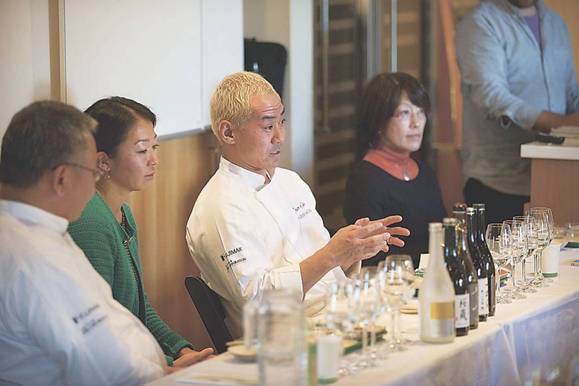Posted on December 12, 2013 On The Japan Times
http://www.japantimes.co.jp/life/2013/12/12/food/umami-an-ideal-sake-pairing/

Good combination: Chefs Kunio Tokuoka (left) and Chikara Yamada (center), speak at a sake-pairing seminar in California, along with Kumiko Ninomiya (far right) of the Umami Information Center.
On a recent September morning in Napa Valley, a sake-pairing session at the Culinary Institute of America’s annual Worlds of Flavor conference began with a lesson in organic chemistry. The theme of the seminar was “sake and umami,” a topic tantalizing enough to fill the room with food and beverage professionals who had traveled to the California conference from around the world to explore trends in gastronomy. Pens scratched notes furiously as Kumiko Ninomiya, of the Umami Information Center in Tokyo explained the science behind umami, the fifth taste, discovered by Japanese biochemist Kikunae Ikeda in 1908.
A fascination with umami has pervaded the food world for the past five years. Chefs are obsessed with it, food writers pepper their articles with references to it and the American hamburger chain Umami Burger spikes everything on the menu with umami-boosting seasonings.
But despite the ubiquity of the term, confusion remains as to what, exactly, umami is. The word describes the savory taste that comes from amino acids and nucleotides in foods such as fish, cheese, tomatoes and dried mushrooms. Unlike the other four basic tastes — sweet, sour, bitter and salty — umami is subtle, more of a feeling than a flavor. Imagine eating a piece of wagyū beef; the mouthwatering, tongue-coating sensation that follows chewing it, and the way that the meaty flavor blooms across the palate. Umami is the tool that allows your tongue to taste in three dimensions.
The amino acid glutamate, which is present in vegetables and fermented foods, is the primary substance associated with umami. But when glutamate is combined with the nucleotides inosinate (found in fish and meat) and guanylate (abundant in dried mushrooms), the result is a taste trifecta that can, according to Ninomiya, “magnify the umami taste up to eight times.” Imagine topping that piece of wagyū beef with Parmesan cheese and shaved truffles and you’ll start to get the idea.
Sake, too, is rich in umami: The enzymatic action of kōji (the catalyst that facilitates the conversion of starch into sugar) in sake-making breaks down proteins and releases high levels of glutamate. Sake contains approximately 180 mg of glutamate per liter, compared with 60 mg per liter for wine.
During the tasting session, celebrated chefs Chikara Yamada, of Tokyo’s Yamada Chikara, and Kunio Tokuoka, of Kitcho in Kyoto, demonstrated the synergistic effect of sake with other umami-rich foods. Yamada had prepared a “sake cocktail aperitif” — small cups containing equal amounts of green tea, dried shiitake mushroom broth and konbu (kelp) broth, alongside a dish of raw scallop.
The chef instructed the audience to first take small sips of each liquid individually, before trying them together with a fruity, floral Isojiman Junmai Daiginjo sake from Shizuoka Prefecture. The change in texture and the roundness of the flavors was remarkable. Next, Yamada paired the scallops with a bright and elegant Juyondai Nakadori Daiginjo from Yamagata Prefecture, a match that underscored sake’s natural affinity for fish.
The attendees were clearly impressed with the experiment. “That was the coolest thing I’ve ever done,” remarked Richard Allardyce, a chef from Toronto, Canada. I’ve always told people that sake is at its best with food. Now, I have the science to back up that claim.
Original Article: The Japan Times
http://www.japantimes.co.jp/life/2013/12/12/food/umami-an-ideal-sake-pairing/
